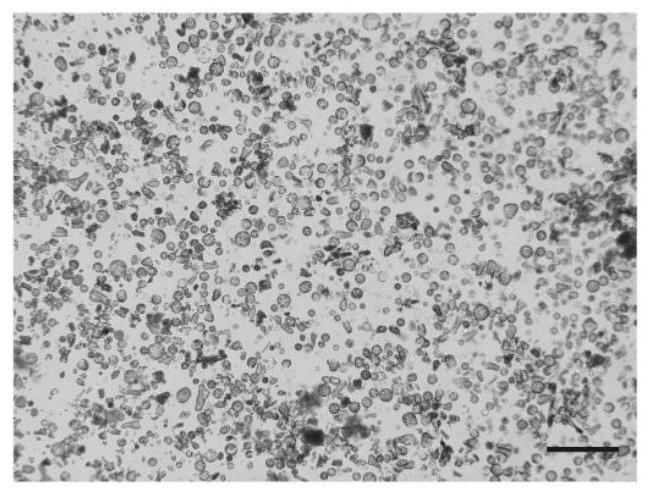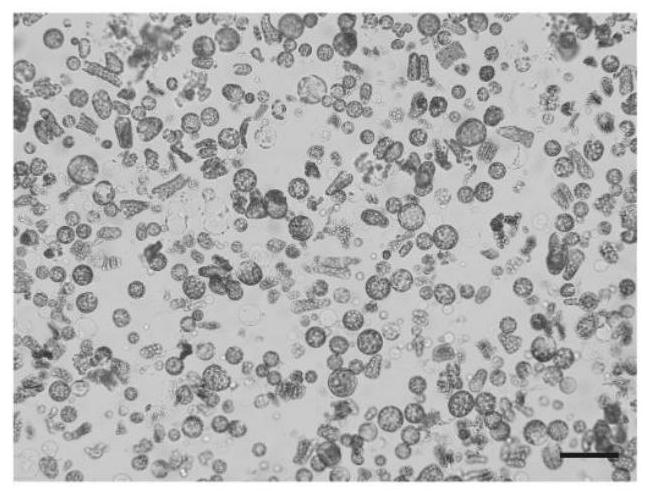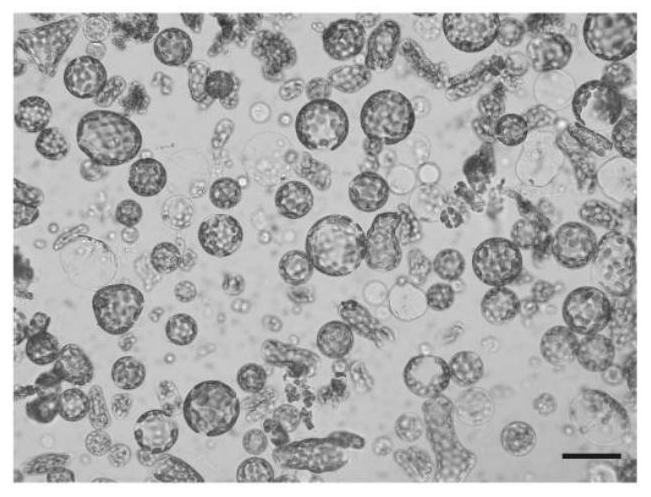A method for efficient isolation and transient transformation of Artemisia annua protoplasts
A protoplast, transient transformation technology, applied in the field of plant biology, can solve problems affecting the progress of scientific research of Artemisia annua
- Summary
- Abstract
- Description
- Claims
- Application Information
AI Technical Summary
Problems solved by technology
Method used
Image
Examples
Embodiment 1
[0070] The present embodiment relates to a method for the separation of protoplast Artemisia annua, comprising the steps of:
[0071] Protoplast preparation:
[0072] (1) Select the vigorous growth of A. annua 2-3 weeks seedlings, when seedlings have 4-6 leaves per plant, leaves tear tape under the skin into the enzyme solution, about 30-40 leaves into . Dark under vacuum 30-40min, placed in a horizontal shaker in the dark enzymatic 4-6h. Enzymatic hydrolyzate of: 1.65% cellulase R10,0.44% macerozyme R10,0.4mol / L mannitol, 0.02mol / L potassium chloride, 0.02mol / L MES pH 5.7, and placed in water bath for 10min 55 ℃ (and so increase the solubility of inactivating the protease enzyme solution), cooled to room temperature and then added 0.01mol / L calcium chloride, 0.1% BSA, the volume to 20mL, filtered stirring to a Petri dish with a 0.45μm filter uniformly middle. The pH is 5.6-5.8 hydrolysates.
[0073] (2) W5 solution was added to 20mL of enzymatic hydrolysis was terminated,...
Embodiment 2
[0082] The present embodiment relates to a method of transiently transformed protoplasts annua PEG-mediated kind, comprising the steps of:
[0083] (1) preparing a plasmid expression vector: The vector used to pCambia1300-GFP, available CAMBIA company from Australia, the plasmid was extracted with endotoxin-free plasmid TianGen large mentioned kit, the extracted plasmid was adjusted to a concentration of about 1μg / μL standby;
[0084] (2) A 10μL plasmid DNA (1μg / μL) was added to 200μL -MMG protoplast suspension, mixed flicking the tube bottom;
[0085] (3) solution was added 220μL of 40% PEG4000, flicking bottom of the tube mixed and placed in the dark at 23 ℃ 20-25min;
[0086] (4) Add 880μL of W5 solution termination transformation mix flicking the tube bottom;
[0087] (5) centrifugation 1000rpm 3min, the supernatant was discarded, the solution was added 1ml W5 of resuspended protoplasts, 23 ℃ light for 12-16 h culture;
[0088] (6) detecting the fluorescent protein: confoc...
Embodiment 3
[0091] The present embodiment relates to the transient expression of the reporter gene in LUC and REN artesunate protoplasts.
[0092] Protoplast Isolation:
[0093] Protoplast Isolation same manner as in Example 2.
[0094] In transient transformation methods PEG-mediated protoplasts annua:
[0095] Expression vector plasmid preparation: The carrier is pGreenII 0800-ALDH1 pro -LUC, pGreenII 0800 promega carrier obtained from the company, ALDH1 pro Artemisinin synthesis promoter last step ALDH1 key enzyme gene, which is NCBI Accession No. proALDH1 (KC118525.1), the plasmid was extracted with the root of the days without toxin kits provide large plasmids and adjust the concentration of the extracted about 1μg / μL standby.
[0096] (1) in 6μL the pGreenII 0800-ALDH1 pro -LUC plasmid (1μg / μL) was added to 200μL -MMG protoplast suspension, mixed flicking the tube bottom;
[0097] (2) was added 220μL 40% PEG4000, flicking bottom of the tube mixed and placed in the dark at 23 ℃ 20-25...
PUM
 Login to View More
Login to View More Abstract
Description
Claims
Application Information
 Login to View More
Login to View More - R&D
- Intellectual Property
- Life Sciences
- Materials
- Tech Scout
- Unparalleled Data Quality
- Higher Quality Content
- 60% Fewer Hallucinations
Browse by: Latest US Patents, China's latest patents, Technical Efficacy Thesaurus, Application Domain, Technology Topic, Popular Technical Reports.
© 2025 PatSnap. All rights reserved.Legal|Privacy policy|Modern Slavery Act Transparency Statement|Sitemap|About US| Contact US: help@patsnap.com



